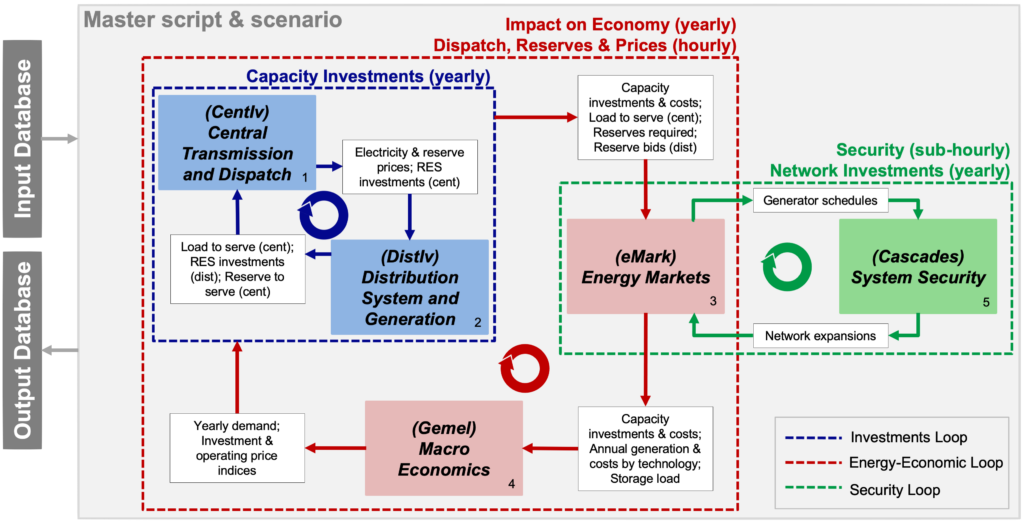Nexus-e
An interconnected energy systems modeling platform
MOTIVATION
Policy changes in the energy sector result in wide-ranging implications throughout the entire energy system and influence all sectors of the economy. Due partly to the high complexity of combining separate models, few attempts have been undertaken to model the interactions between the components of the energy-economic system.
The Nexus-e Interconnected Energy Systems Modeling Platform aims to fill this gap by providing an interdisciplinary framework of modules that are linked through well-defined interfaces to holistically analyze and understand the impacts of future developments in the energy system. This platform combines bottom-up and top-down energy modeling approaches to represent a much broader scope of the energy-economic system than traditional stand-alone modeling approaches.
METHODOLOGY
The figure on the left shows an overview of the Nexus-e framework including
- the five core modules (colored boxes),
- the three loops (colored arrows),
- the interfaces (white boxes, for visualization purposes some of the interfaces are combined in the figure).
The five core modules
The Nexus-e Platform consists of the following five core modules.
The GemEl module is a computable general equilibrium (CGE) model of the national economy. Its solutions represent decentralized market outcomes where all agents (firms and households) maximize their objectives taking market prices as given. The purpose of the GemEl module is to provide realistic reactions of economy-wide electricity demand to changes in the cost of supplying electricity and to estimate the impacts of changes in the power sector on consumer welfare. It operates on an annual time scale. Calibrated to Swiss the national input–output table of 2014, GemEl has a detailed resolution of economic activities (up to 77 economic sectors) and their interdependencies, which allows for tracking the effects of changes in the electricity sector throughout production chains. Consumer welfare is affected by both changes in consumer prices and changes in wages and capital rents. GemEl represents final consumption by 14 household types and is able to capture the distribution of welfare changes across these.
The CentIv module aims to co-optimize generation investment and operational decisions on the transmission system level for a target year. The module is geared towards providing results with high temporal and spatial resolution from the perspective of a centralized decision maker. In its formulation, the module includes detailed dispatch, reserve and investment constraints for a wide range of flexibility providers and is tailored to give insight into how real-size power systems would evolve and cope with projected increase in intermittent renewable energy source generation. CentIv has an important role within both the investment and energy-economic loops of the Nexus-e framework.
The DistIv Module aims to jointly optimize the investments and operations of a distribution system to satisfy the demand and policy targets while minimizing total costs, considering potential trading of energy and reserve with the transmission system. The components considered in the distribution system include distributed energy resources such as storage units, demand response programs, variable and dispatchable generation units.
The eMark module aims to simulate a market-based clearing of electricity and reserve supply offers and demand bids. This module is designed to mimic the actual sequential structures and timing currently employed to clear all electricity market products. Additionally, eMark is setup to apply realistic constraints for intra-zonal trading that reflect the current market coupling mechanisms. The module is structured to provide high temporal (hourly) resolution and moderate spatial (zonal) resolution equivalent to those of the existing market processes. eMark has the important role in the Nexus-e framework to provide a market-based perspective and enable assessments of future market structures.
The Cascades module aims to: (1) assess the security of supply by testing the capability of a power system to withstand sudden changes, i.e. due to component failures; and (2) to provide a transmission system expansion plan if a target level of security is not satisfied. The Cascades module comprises two models, a cascading failure simulations model and a transmission system expansion planning model.


The three loops
The Nexus-e Platform consists of the following three loops.
The Investment loop connects CentIv and DistIv with the purpose of modeling a coordinated generation expansion planning process at the transmission and distribution system levels. By combining these modules, the trade-offs from benefits and costs of investments in the centralized and distribution systems can be accounted for, yielding an expansion strategy for power generation that considers both layers.
The Energy-Economic loop connects all modules with the exception of Cascades. The investment decisions made by CentIv and DistIv are used by eMark to determine the hourly generator schedules and operating expenses. Then, the investment costs, operating costs, and generation supply mix are handed over to the macroeconomic module GemEl, which re-establishes the equilibrium and adjusts the demand. The adjusted demand is sent back to the CentIv and DistIv modules to begin a new iteration of this loop. Convergence is reached when the annual demand result from GemEl does not change more than 2%.
The Security loop connects eMark and Cascades with the purpose of assessing the system security after the Energy-Economic loop converges (i.e. after the investments in power generation are made). Furthermore, in the Security loop transmission system investments are proposed (upgrades of branches and transformers), if the reference system security is not satisfied. This loop serves as a security assessment and does not feedback to the other loops.

The interfaces
A novelty of the Nexus-e platform is that it connects the core modules with structured and automated interfaces to pass all necessary information between modules. These interfaces are defined as one function within each module and when called upon they package the required results data from their module into a specific data structure and send this structure as input to another module.
The Nexus-e Platform consists of the following interfaces.
- CentIv-DistIv interface: CentIv sends to DistIv results for the nodal demand, nodal electricity and reserve prices, total system reserve requirements, total electricity generated and total costs incurred by the newly invested units, electricity produced from the renewables and the renewable energy target.
- DistIv-CentIv interface: DistIv sends to CentIv results for the residual nodal demand and total distributed generation, residual reserve requirement and investments in non-dispatchable distributed generation units (i.e. photovoltaic in DistIv).
- GemEl-Investments interface: GemEl sends to the Investments loop (CentIv and DistIv) informa- tion on the yearly electricity demand along with changes in the price indexes of investments and generation costs.
- Investments-eMark interface: the Investments loop (CentIv and DistIv) sends to eMark results for the investment decisions, reserve requirements, residual electricity demand, generator curtailments, demand shed, and hydro dam monthly storage levels.
- Investments-GemEl interface: the Investments loop (CentIv and DistIv) sends to GemEl results for the fixed costs and investment costs by technology type, including newly built units, on both the transmission and distribution system levels.
- eMark-GemEl interface: eMark sends to GemEl the generation mix and operating costs by technology type along with the export/import of electricity.
- eMark-Cascades interface: eMark sends to Cascades the generation dispatch, reserves, and export/import.
- Cascades-eMark interface: Cascades sends to eMark a list of network upgrades.



